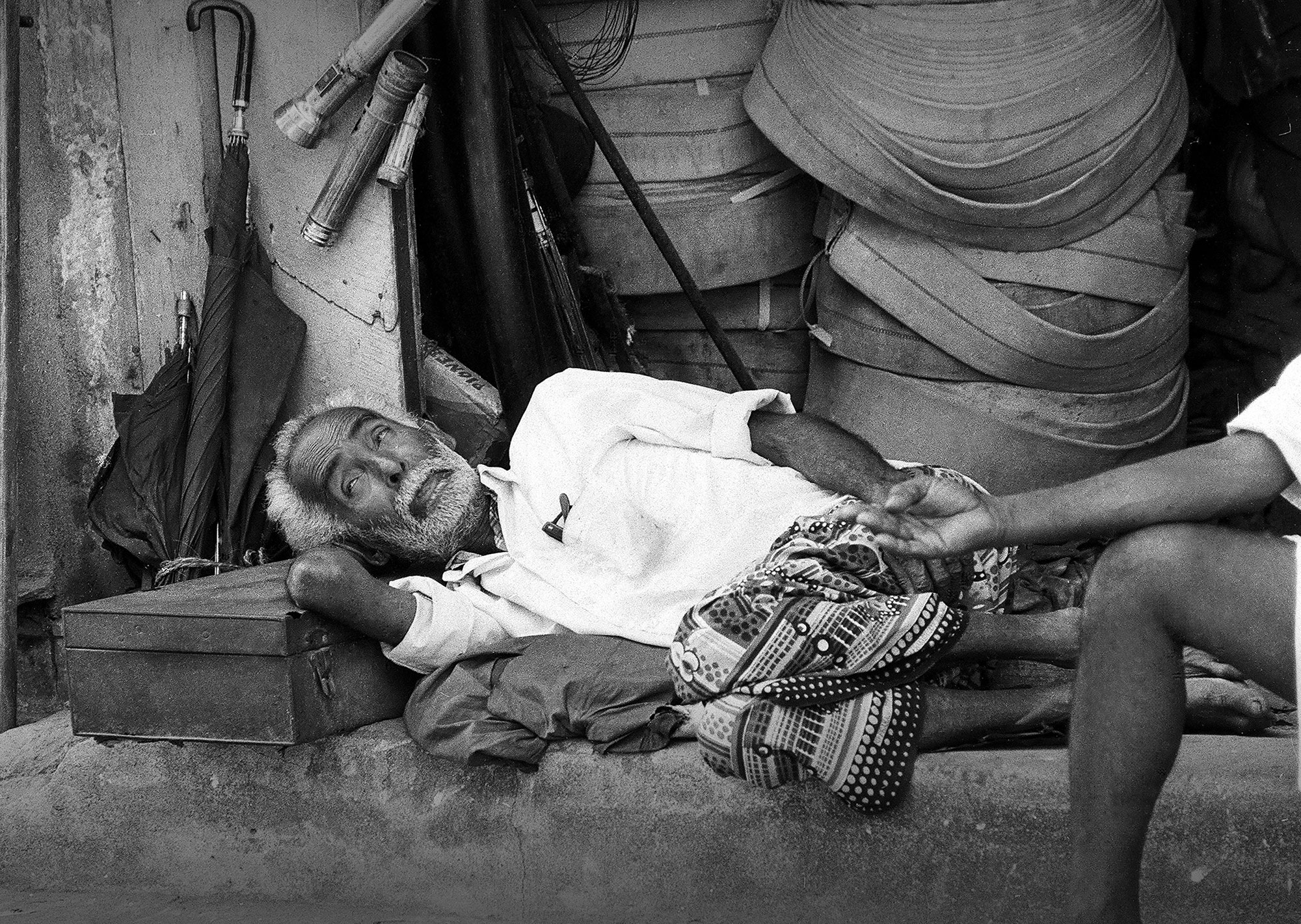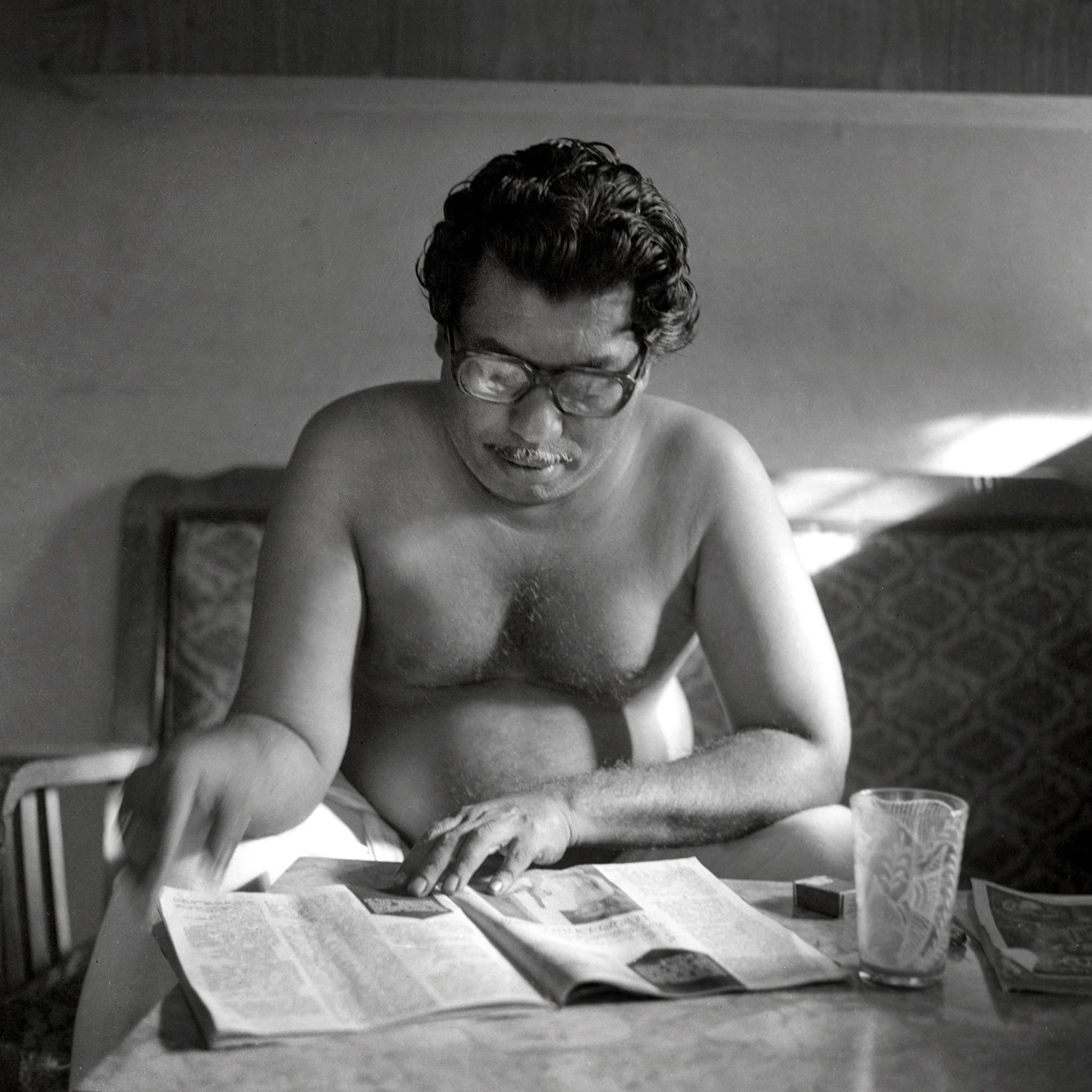Panorama
Digital Moon
and
Analogue
Nights
Photo Mail presents
A panoramic view of
The art of photography’s
Interaction and
Interrelation with other
Art mediums such as literature
Architecture, and
Other visual media
In this autobiographical
memoir Abul Kalam Azad
discusses his versatile journey
as a photo-artist, drawing
parallels to the socio-political
context, personal history
and art. The acclaimed
pieces were originally
published in the popular
Malayalam journal
Deshabhimani for
over a year (2019 – 2020)

Boatman © Abul Kalam Azad 1980 – 85
I enjoy being on the road; a probable inheritance from my tribe who never stopped moving from place to place. When we were children, every week we would visit Muvattupuzha, where my mother’s home was. The 50 km from Kochi to Muvattupuzha meant a sea change. While the former was an ancient seaport town, the latter was a village with rivers, paddy fields and large groves of trees. As we left the town and got near to the village, the magnificentchanges occurred to the landscape was deeply joyous to watch. At times we went by car, which meant extra stops on the way. Almost everyone in the village was related to us and everywhere children would gather up for playtime.
A family trip to Coimbatore, when I was 11 or 12 years old, is particularly unforgettable. This was with my aunt and her children to attend a wedding. As my forefathers were from the current Tamil Nadu, we had family members settled in different parts of Kerala and Tamil Nadu. I may have visited the place earlier, but that long train journey was etched forever in my mind. “Look, a horse”, I yelled, seeing a donkey for the first time. I was fascinated by the unfamiliar landscape, flora and fauna, weather and the array of different smells. An unimaginably new and different world was magically unfolding before my little eyes for the first time. Coimbatore was several times bigger and crowded than Kochi. Although it was too much for a child to process, it made me more and more curious and inquisitive.
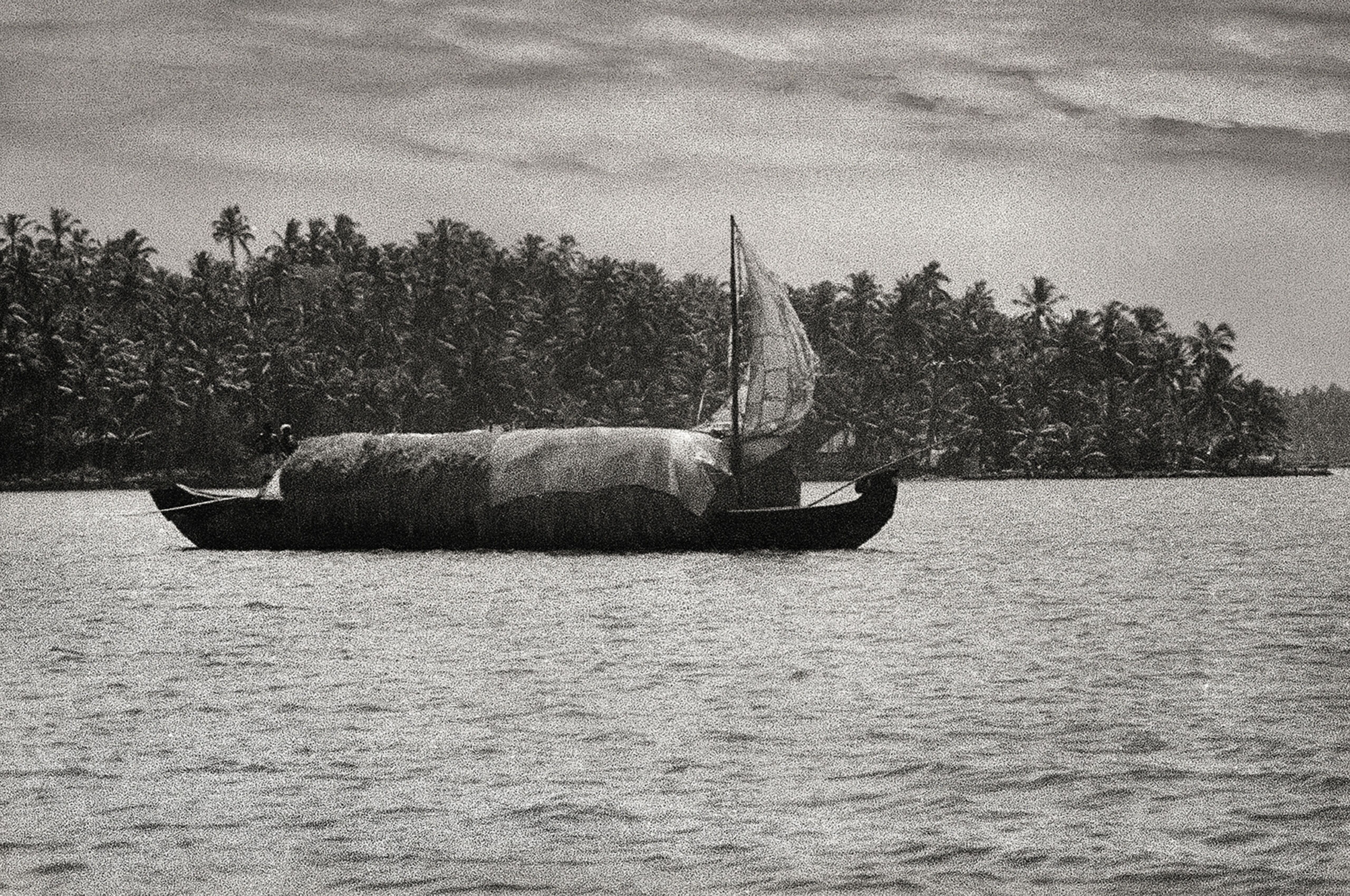
House Boat © Abul Kalam Azad 1980 – 85
As the family trips instilled a keen desire to travel further and connect deeper, I gradually started venturing into unknown places with friends. I used to save my pocket money on buying film rolls. That meant no money for the road. So, I would explore every possibility for traveling without money – bicycling, hitchhiking, ticketless train etc., and we made it to the distant destinations of our vast country.
Adulthood made most of my friends settle down and start a job and family life, but I was not deterred. My long, lonely trips were in wait. Like a restless river, I kept flowing to places far away. I could have inherited this from the nomadic spirit of my ancestors who had always been on the move for trade, study or mere pleasure. I also became a voracious reader, mostly devouring Malayalam fiction and non-fiction, as English evaded me those days. It was a blessing as regional roots in culture and literature make one more grounded.

Truck Driver, Gujarat © Abul Kalam Azad 1980 – 85
Those early moneyless travels were fun but not easy. The joy of meeting different people and participating in their lives was met with the unending fear of being caught by train ticket examiners and the constant worries about next meal. Sleeping in railway stations or roadside inns or village houses of newly met acquaintances was exciting, but uncomfortable. On the one hand, uncertainty about the next day thrilled you, but on the other hand, there was a nagging temptation to turn back and rush to the safety of home. But, the undying search for newer experiences kept me going. As there wasn’t any pre-decided destination, I often went wherever the supportive truck drivers took me. Their world of dhabas, local bars, tea shops, opium and brothels was quite opposite to that of my cozy childhood journeys. Nonetheless, the welcoming nature of the pre-Hindutva Indian mindset made the journeys safe and frictionless. Neither religion nor caste was a question that bothered us. Wandering individuals weren’t looked upon with suspicion; rather, they were invited for a free meal or chai. When an illness or extreme fatigue overpowered my zeal to travel, I would write to my mother or a friend, asking for money. This was a time before mobile phones or Google pay transactions, and it would take a week to ten days for the money order to arrive. The next train would take me back home.

Rain © Abul Kalam Azad 1980 – 85
As these trips were neither sponsored nor commissioned by any agency or foundation, publishing the travel photographs never crossed my mind. The possibility of exhibiting and selling them was unheard of at that time. Every photograph has immense value and carries vital information as a document. However, photographing unfamiliar people, places and events have an inevitable drawback. Most often, the photographer is a mere witness and chronicler, and the subjects aren’t involved in the creative process. Unknown places, incomprehensible language and strange people make a photographer a disengaged voyeur or Flâneur. Often the subjects are not even aware that they are being photographed. I felt something was amiss there. I also missed the interactive way with which I was photographing my friends, family and familiar surroundings.
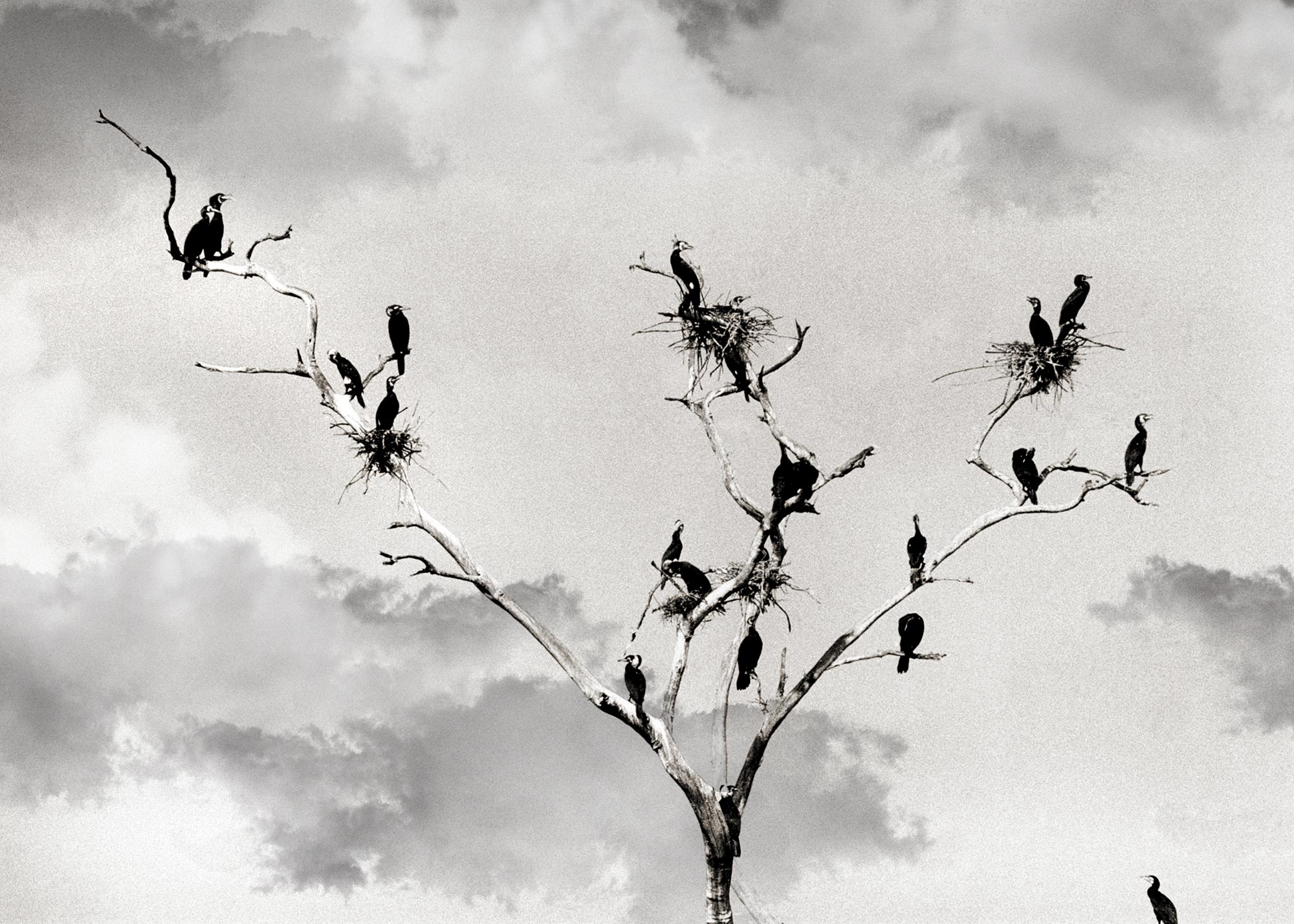
Cormarant © Abul Kalam Azad 1980 – 85
Later, it took almost a decade more for me to grasp the history and nuances of Indian photography. Immediately after its invention, photography was introduced to India by the British as a tool to promote colonial India as a destination for travelers and investors. To suit that purpose, exotic images of this ancient land, its magnificent buildings, diverse landscapes, bizarre rituals and ancient people were shot by the visiting photographers and army generals. All of these missions were commissioned by the Palace. During the Indian Mutiny of 1857, on their own volition, the photographers started documenting the agitation and the agony.
Most of the Indian photographers learned from their foreign masters and hence, their styles continued to dominate Indian photography. They were either voyeuristic visual trophies that professed, “I had been there, seen that, met him”, or a tool that propagated “top-down let’s-look-at-the-suffering” sort of charity or propaganda of the photographer/client.

Hyderabad © Abul Kalam Azad 1980 – 85

Andhra Pradesh © Abul Kalam Azad 1980 – 85

Pushkar © Abul Kalam Azad 1980 – 85

Rikshawalas, Bombay © Abul Kalam Azad 1980 – 85
The travel photographs that I shot in the 1980s weren’t an exception to this Indian phenomenon. However, my lack of academic education in photography and exposure to the works of early Indian and International photographers was, in a way, a boon, as I wasn’t influenced much by the prevailing norms and standards. Still, it is difficult to completely escape the element of exoticism that is inherent to destination/street photography. Eventually, I quit travel photography that invariably makes or promotes a place as a destination. Nonetheless, I continue to travel to create my art.
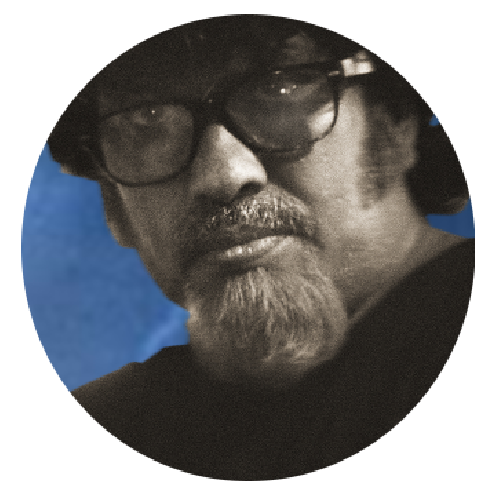
Abul Kalam Azad is an established contemporary Indian photographer, noted for his maverick experimental and conceptual works. He is the Founder Chairman of Ekalokam Trust for Photography. Abul’s photographic works are predominantly autobiographical and explore the areas of politics, culture, contemporary micro-history, gender, and eroticism. His works attempt a re-reading of contemporary Indian history – the history in which ordinary people are absent and mainly provided by beautiful images and icons. To see more works of Abul Kalam Azad check his website.
Published on March 10, 2021
Share
Related Articles
Hitchhiking Days
Most of the Indian photographers learned from their foreign masters and hence, their styles continued to dominate Indian photography. They were either voyeuristic visual trophies that professed, “I had been there, seen that, met him”, or a tool that propagated “top-down let’s-look-at-the-suffering” sort of charity or propaganda of the photographer/client.
Mattancherry: My Cosmopolitan Hometown
Mattancherry has been a microcosm of authentic cosmopolitanism, many ethnicities and faiths coexisting together, with its beautiful contrasts and combinations. I grew up there, in one of its small boroughs called Kochangadi. This Muslim dominated waterfront settlement had – and still has – a few Jewish, Ezhava and Christian families. Apart from a synagogue and a few churches, there are several small and big mosques that belong to different ethnic groups or factions of Muslims.
Sepia Tinted Memory
Our family name is Pattanam, an acronym for the Tamil word Patthanathukarar (which means ‘hailing from a port town’). We could have been from one of the earliest seaports of Tamilakam (the region corresponding to the present South India) such as Kaveripoompatanam (Chola Port Pukar) or Kayalpattanam (Pandyan Port Korkai). Trading took my forefathers to different parts of Tamilakam and they eventually settled in Mattancherry.


